Mechanically induced phase transformation of zinc sulfide
Mechanically induced phase transformation of zinc sulfide作者机构:University Erlangen-NurembergInstitute of Particle Technology
出 版 物:《Particuology》 (颗粒学报(英文版))
年 卷 期:2015年第13卷第1期
页 面:1-10页
核心收录:
学科分类:081702[工学-化学工艺] 08[工学] 0817[工学-化学工程与技术]
主 题:Polymorph transformationZinc sulfide Molecular dynamics simulation Wet milling Powder compression
摘 要:Molecular dynamics (MD) simulations of the consecutive compression-decompression cycles ot hexagonal zinc sulfide (wurtzite) nanoparticles predict an irreversible phase transformation to the cubic *** phase transformation commences at the contact area between the particle and the inden- ter and proceeds with the number of compression cycles. Dislocations are visible for a particle size above 5nm. Results from wet grinding and dry powder compression experiments on a commercial wurtzite pigment agree qualitatively with MD simulation predictions. X-ray diffraction patterns reveal that the amount of cubic polymorph in the compressed samples increases with pressure applied to the powder. In comparison with powder compression, wet milling leads to a more pronounced phase transformation. This occurs because the particles are exposed to a large number of stress events by collision with the grinding media, which leads to the formation of defects and new surface crystallites by particle fracture. According to the MD simulations, phase transformation is expected to occur preferentially in surface crystallites because they experience the highest mechanical load. Because of the phase transformation, the wet ground and compressed samples exhibit a lower photo- luminescence intensity than the feed material. In comparison with powder compression, milling reduces the photoluminescence intensity more substantially. This occurs because a higher defect concentration is formed. The defects contribute to the phase transformation and photoluminescence quenching.



